The Spark
I was watching Jack, almost 3, and Mary, who was 10 months old. It was getting crazy. I was trying to write an article and keep the Christmas Tree from tipping over for the third time that day. I began asking myself, “What can I get Jack interested in?” We have a large rain stick in the living room, so I got it out.
Jack was fascinated. He tipped it upside down many times to hear it “rain”. I asked him if he knew how the rain stick worked. He didn’t. So, I used my fingers to explain how there were crossed spines inside and small seeds. When the seeds hit the spines, they made the sound. I could see he was a bit confused.
Figuring It Out
“Jack, do you know what a cactus is?” “No?” “I’ll bet we can find one on the computer.” (I didn’t have any books on cacti in my library.) We went to the computer and pulled up some pictures of cacti. I explained that when the cactus dies, the arms can be made into rain sticks before they dry. I showed him some cacti with long spines and explained that the spines are pushed into the dead cactus. We got our rain stick, and I was able to let him feel the ends of the spines in the stick.
With Jack on one knee and Mary on the other, we googled making a rain stick. The first thing up was a video series showing how to make a rain stick from a cardboard tube. We watched the video on how to choose a tube. We watched how to insert the spines, which were made of nails, pins, or toothpicks. We watched the first part on covering the tube ends, and finished off with the video on what to put inside.
Jack was fascinated and watched all the videos. He didn’t get bored or wiggly. I helped him stay tuned in by having mini-conversations. “Look, Jack, there are three lengths of tubes. Which size would you choose?” “Hey, look, she is using nails and a hammer. You would like to hammer nails, I bet.” “See those toothpicks, they would make a really different sound.” It went on and on, and he was fully engaged with how it was done. (The hardest part so far was keeping Mary’s hands busy and off the keyboard!)
Creating Our Rainstick
“You know what, Jack, I’ll bet we can make a rain stick.” “Yeahhhhh”, he said. We pulled out our really great junk box and found a long tube that we thought might work. I handed it to Jack, he put it up to his eye and said, “Hey, it’s my looker looker”; so much for the rain stick. LOL
We took our tube, some straight pins, and duct tape to the kitchen. Jack was content to watch me make the rain stick. He tried pushing in a pin, but decided it hurt his thumb. We talked about dead cacti, thorny spines, and rain sticks while I pushed in pins and taped on an end. Jack chose red lentils and rice to put inside.
He was interested in how the spines looked from the inside of the tube. He understood now what I had been showing him with my fingers, and he showed it back to me. Then I taped the other end and covered the whole thing with duct tape. A rain stick is normally covered with paper or cloth and then painted or decorated, but I wanted to be sure those pesky pins didn’t come out.
Jack excitedly turned it over. It didn’t “rain”. There was just a spattering thunk. Hmmmmm. He tried it a few times. Then he looked at me and, with a serious face, said, “It’s too little,” (meaning short). He had figured out that there was no rain sound because the tube was too short. Amazing! Aren’t children smart?
I told him that we could construct a rain stick out of three toilet paper tubes taped together. He was all for that and rummaged in the junk box for the tubes. Then his enthusiasm waned. He and Mary busied themselves with trucks on the living room carpet while I taped the tubes together. Then I called Jack in and told him I was going to use toothpicks this time and showed him how it would work. Then he was off again to Mary and the trucks. I finished the tube and called Jack in to put the rice inside. I finished taping the ends and covered them with duct tape. Then I called Jack, and he gave it a try. His face beamed when it “rained.”
When his mom returned home, he showed her the rain stick, and I explained about the dead cactus. She said, “Jack knows about cacti. Remember the story about the boy and his bottom.” A wide grin spread over Jack’s face as he recalled the Dr. Seuss story about a boy who sat on a cactus. Now it all came together in his mind.
It was a great time and took only about forty minutes from start to finish; just a mere 40 minutes, and Jack learned so much and had a lot of fun. Then I went back to my article, and Jack and Mary played with the trucks till their mom got home.
Helping children LOVE learning is about catching a spark from a child (in this case, seeing Jack’s interest in the rain stick), then responding.
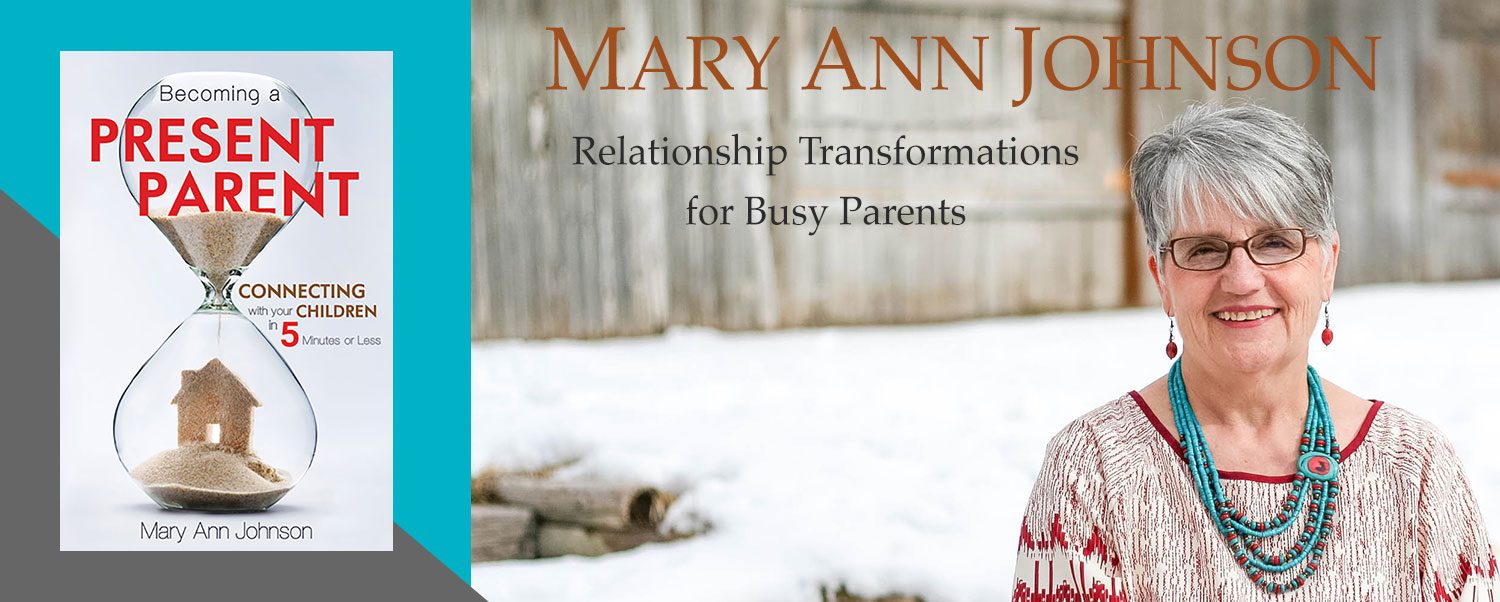
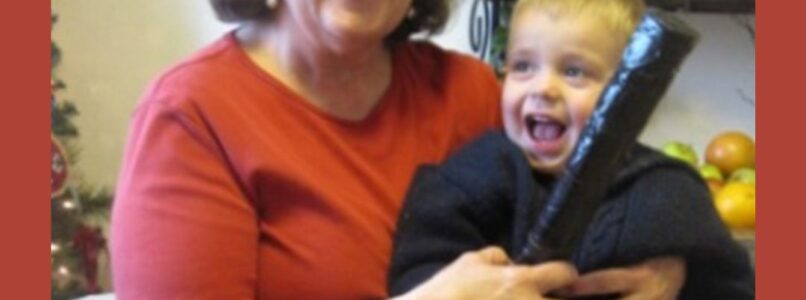
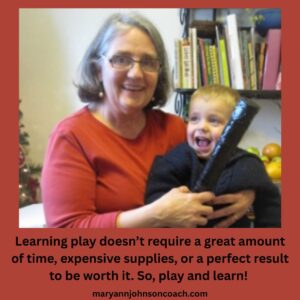
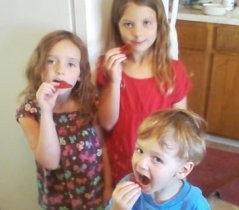
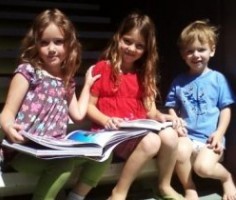 Later, I found Lizzy and Ashley sitting at the bottom of the stairs, looking at the books they brought home from the library. They had originally gone out to ride their scooters, but the books were so compelling that they never made it to the driveway. They were comparing the crystals in each other’s books, chatting away about the shapes, sizes, and colors.
Later, I found Lizzy and Ashley sitting at the bottom of the stairs, looking at the books they brought home from the library. They had originally gone out to ride their scooters, but the books were so compelling that they never made it to the driveway. They were comparing the crystals in each other’s books, chatting away about the shapes, sizes, and colors.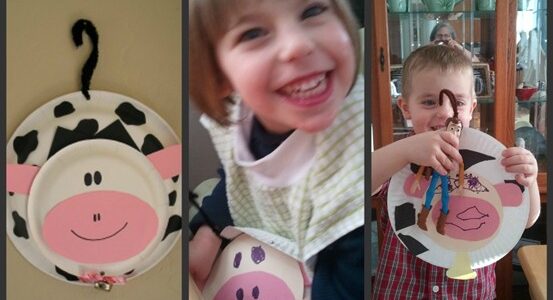
 When I first began writing and publishing articles, it was in 2010. My grands, the ones I still live with, were all under five. As their grandma, I wanted to find ways to play and connect. I’m not a board game person! Tea parties and dress up are not on my list of fun things! The truth is, I like learning. I always have. I thought a lot about how I could ‘play’ with my grands and make it work for all of us. What I came up with was learning for fun. Every Tuesday, for several years, we would gather and play/learn. They looked forward to it and occasionally would tell me what they wanted to know or ask about at our next Tuesday session. It was a hit and was called Grandma School. : )
When I first began writing and publishing articles, it was in 2010. My grands, the ones I still live with, were all under five. As their grandma, I wanted to find ways to play and connect. I’m not a board game person! Tea parties and dress up are not on my list of fun things! The truth is, I like learning. I always have. I thought a lot about how I could ‘play’ with my grands and make it work for all of us. What I came up with was learning for fun. Every Tuesday, for several years, we would gather and play/learn. They looked forward to it and occasionally would tell me what they wanted to know or ask about at our next Tuesday session. It was a hit and was called Grandma School. : ) the pictures and I told them fun cow facts, such as, “Did you know a cow has four stomachs. You only have one, but a cow has four!!” That type of comment is usually followed by a question such as “Why Grandma?” Then we get to learn a bit more. Jack’s favorite cow fact was: “Daddy cows are called bulls and they go Moo really, really loud.” I did such a great daddy cow impersonation that it sent Jack into gales of laughter.
the pictures and I told them fun cow facts, such as, “Did you know a cow has four stomachs. You only have one, but a cow has four!!” That type of comment is usually followed by a question such as “Why Grandma?” Then we get to learn a bit more. Jack’s favorite cow fact was: “Daddy cows are called bulls and they go Moo really, really loud.” I did such a great daddy cow impersonation that it sent Jack into gales of laughter.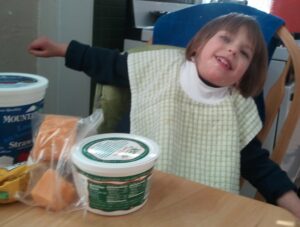 After the books, we did a cow activity. I had created a picture sheet on my computer that showed cool foods that are made from cow’s milk: cheese, cream, ice cream, milk for cereal, cottage cheese, sour cream, etc. I also had the real item on the table, if we had it. We looked at the pictures, talked about each item, and then tasted it. Of course, we all liked the cookie dough best. (It has milk in it!)
After the books, we did a cow activity. I had created a picture sheet on my computer that showed cool foods that are made from cow’s milk: cheese, cream, ice cream, milk for cereal, cottage cheese, sour cream, etc. I also had the real item on the table, if we had it. We looked at the pictures, talked about each item, and then tasted it. Of course, we all liked the cookie dough best. (It has milk in it!) way, but then switched to using two hands and having me hold and turn the paper. Special scissors with 4 finger holes allowed me to help Maggie cut her own cow spots. She was thrilled. (Remember, Maggie, who is now eighteen, has severe cerebral palsy, so doing anything with help thrilled her and still does.)
way, but then switched to using two hands and having me hold and turn the paper. Special scissors with 4 finger holes allowed me to help Maggie cut her own cow spots. She was thrilled. (Remember, Maggie, who is now eighteen, has severe cerebral palsy, so doing anything with help thrilled her and still does.)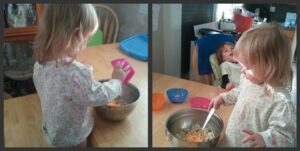 We ended the day by making mac and cheese. Cooking was a favorite activity, so everyone helped. The kids liked tasting the powdered cheese. We had our mac and cheese for lunch, and it was delicious. Maggie, Jack, and Mary decided that having cows in our world is a very good thing.
We ended the day by making mac and cheese. Cooking was a favorite activity, so everyone helped. The kids liked tasting the powdered cheese. We had our mac and cheese for lunch, and it was delicious. Maggie, Jack, and Mary decided that having cows in our world is a very good thing.